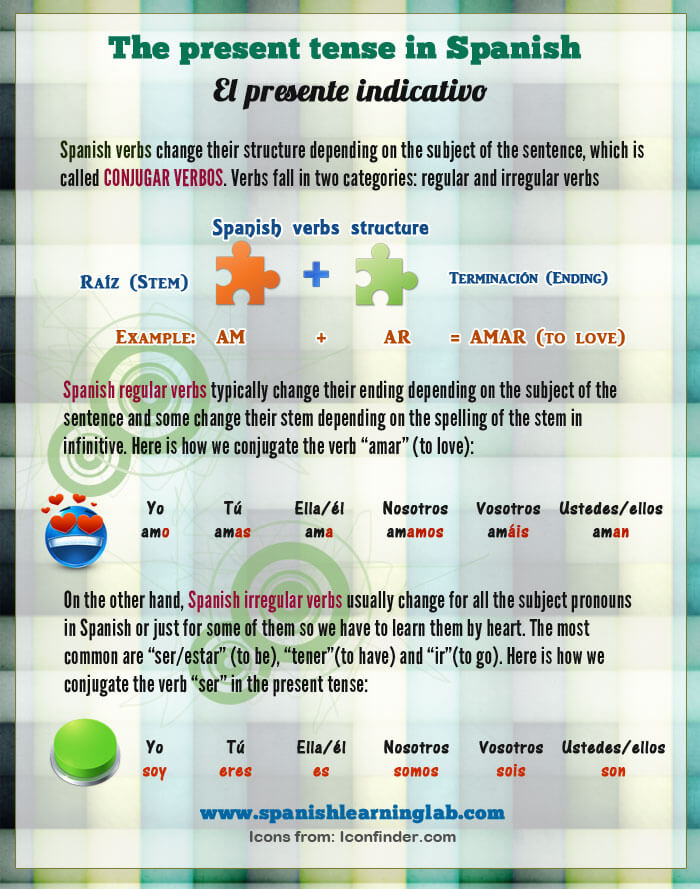Just like in English, there are rules for tenses and verbs in Spanish. The present tense itself has three major conjugation moods: the indicative, the subjunctive and the imperative mood. This lesson will teach you how to conjugate regular verbs in Spanish in the indicative, which is one of the simplest and the most commonly used in the language. This lesson includes a video with interesting examples and explanations, as well as many other resources like pictures and interactive quizzes. Let’s begin…
Introductory video: Conjugating Regular Verbs in Spanish
Regular verbs in Spanish are very common and useful in everyday interactions. We will begin the lesson with a short video explaining how they work and how to conjugate these verbs in the present tense. Remember, you can activate the subtitles if you need to translate or check how something is written in the language, and please make sure to stick until the end of the video to understand the rest of the lesson more easily.
The difference between Regular and Irregular Verbs in Spanish
All Spanish verbs have something called RAÍZ or a stem at the beginning, just like AM- in AMAR. The majority of verbs in the language will not suffer any stem change when conjugated, which is why they are considered regular verbs. “La raíz” or root of the verb is made up of the first syllables or letters of the verb, except for the endings, which must be -AR, -ER and -IR, as shown in this chart:
| Verbo original | Raíz (verb’s root) | Terminación (ending) |
| Cantar | Cant- | -ar |
| Temer | Tem- | -er |
| Abrir | Abr- | -ir |
For these type of verbs, the ending or last part of the word will always be modified depending on the subject that the action is targeting. Take a look at the picture below. It explains some differences between regular and irregular verbs in Spanish, as well as how to conjugate the verbs “AMAR” (to love) and “SER” (to be).

Conjugating -AR regular verbs in Spanish
Words like AMAR (to love), BESAR (to kiss) and PLANEAR (to plan) are common examples of -AR regular verbs in Spanish. All the letters, except for the AR ending, are part of the verb’s stem or “raíz del verbo”. To conjugate AR ending verbs, we will replace the -AR suffix with a particular group of letters following specific rules. For example, AMAR will be conjugated as AMO for the subject pronoun “YO”, as shown in these examples:
- Correct: Yo amo leer libros en mi tiempo libre. (I love to read books in my free time.)
- Incorrect: Yo amar leer libros. (we must use the right form of the verb instead)
In this case, we replaced the -AR ending for the vowel -O. The following image shows a list of very common -AR ending regular verbs, as well as the conjugation pattern these verbs must follow. There is no need to use a pronoun all the time, and actually they could be omitted in most sentences and the meaning would not be affected. However, it is important to use the right conjugation for the subject we are referring to, even if we do not mention it, for example, the following sentences are grammatically correct and identical in meaning:
- Marcelo cuida de su abuela. (Marcelo takes care of his grandma)
- Él cuida de su abuela.
- Cuida de su abuela.
Sentences with Regular verbs in Spanish with AR endings
Here are some examples of sentences applying the conjugation rules for regular verbs in Spanish with AR endings. Pay attention to the way the ending must be modified based on the pronoun (subject) in the sentence. Click on the PLAY to listen to the examples
|
Yo amo la poesía
I love poetry
|
|
Tú amas la música
You love music
|
|
Vos amás tocar guitarra
You love playing guitar
|
|
Ella ama a su marido
She loves her husband
|
|
Nosotros amamos ver películas
We love watching movies
|
|
Vosotros amáis el clima
You love the weather
|
|
Ellos aman a su país
They love their country
|
Conjugating -ER ending regular verbs in Spanish
The rules are quite similar for ER ending regular verbs like COMER (to eat). For instance, the conjugation for the pronoun YO would be formed by replacing ER for the vowel –O, just like this: “Yo como”. As you can see, all AR, ER and IR ending regular verbs in Spanish will be conjugated the same way for the pronoun YO, so all you have to memorize are those endings that are different for each type of verb. It is possible to replace the pronoun for a name or an object that agrees with it, for example:
- Yo aprendo cosas prácticas fácilmente. (I learn practical things easily)
- Nosotros (Ana y yo) aprendemos español en esa escuela. (We learn Spanish in that school.)
The image below presents other very common regular verbs that end in ER in Spanish:

Sentences in Spanish with ER ending verbs in the present tense
Below, you can find some sentences with the regular verb COMER in Spanish. Remember that you can conjugate any of the verbs in the list above in the same way as COMER by modifying their ending, e.g. “Yo prometo”, “Tú rompes”, etc. Furthermore, remember that it is possible to replace the pronoun with a name or an object that agrees with it in sentences, for example: Ana (ella), La flauta (ella), El perro (Él) and so on.
|
Yo como bastantes verduras
I eat a lot of vegetables
|
|
¿Tú comes carne de cerdo?
Do you eat pork?
|
|
Vos comés demasiado
You eat too much
|
|
El perro come todo tipo de comida
The dog eats all type of food
|
|
Nosotros comemos juntos todos los días
We eat together every day
|
|
Vosotros coméis cosas deliciosas
You eat delicious food
|
|
Las aves (Ellas) comen varias veces al día
Birds eat several times a day
|
Conjugating -IR ending regular verbs in Spanish
Finally, the last group of regular verbs will be formed by regular verbs in Spanish ending in IR like VIVIR (to live). Again, we will replace the IR ending depending on the subject of the sentence, just like this:
- Yo vivo en Londres. (I live in London)
- Ana vive en París/Ella vive en París. (Ana lives in Paris)
- Vosotros vivís en España. (You live in Spain)
Make sure to compare these endings with the ones above so that you can see how similar the three different conjugations are (with the variation of a vowel or a tilde). Being aware of these similarities may help you apply these rules more easily. Some key regular verbs in Spanish with -IR ending are shown in the picture below, as well as the way to conjugate them:

Sentences with regular verbs ending in IR in Spanish
|
Vivo en un pueblo cercano
I live in a town nearby
|
|
¿Vives en la misma ciudad?
Do you live in the same city?
|
|
Vos vivís en un lugar muy bonito
You live in a very nice place
|
|
Carlos vive con su mamá
Carlos lives with her mother
|
|
Nosotros vivimos en otro país
We live in another country
|
|
Vosotros vivís en buenas condiciones
You live in good conditions
|
|
¿Quiénes viven contigo?
Who lives with you?
|
Related Spanish Worksheets:
- Basic Sentence Structure in Spanish
- Spanish Regular -AR Verbs in the Present Tense (Common verbs + sentences)
- Conjugating -AR Regular Verbs in Spanish (Present) (Chart + sentences)
- Spanish Regular -ER Verbs in the Present Tense (Common verbs + sentences)
- Conjugating -ER Regular Verbs in Spanish (Present) (Chart + sentences)
- Spanish Regular -IR Verbs in the Present Tense (Common verbs + sentences)
- Conjugating -IR Regular Verbs in Spanish (Present) (Chart + sentences)
- Spanish Verbs Conjugation (Present Tense)
- The Structure of Spanish Sentences

This was fun!! Your explanations are very easy to understand, plus I don’t feel intimidated by them.
Gracias! I am glad you liked this lesson!!!
I am a brazilian girl and I can speak english as well so I am enjoying a lot this website, I am able to practice my english and study spanish at the same time, thank you!
We are happy to hear that Marina 🙂 Creo que el portugués y el español son muy similares.
Keep up the good work. Thank-you for the help.